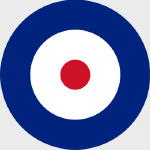Corgi AA28902 RAF Bristol Beaufort Mk.1 Torpedo Bomber - L9866, No.217 Squadron, St Eval, Cornwall, Attack on the German Cruiser Admiral Hipper, February 1st, 1941 (1:72 Scale)
"Woe to the unwary"
- Motto of No.217 Squadron
 The Bristol Beaufort (manufacturer designation Type 152) is a British twin-engined torpedo bomber designed by the Bristol Aeroplane Company, and developed from experience gained designing and building the earlier Blenheim light bomber. At least 1,180 Beauforts were built by Bristol and other British manufacturers.
The Bristol Beaufort (manufacturer designation Type 152) is a British twin-engined torpedo bomber designed by the Bristol Aeroplane Company, and developed from experience gained designing and building the earlier Blenheim light bomber. At least 1,180 Beauforts were built by Bristol and other British manufacturers.
The Australian government's Department of Aircraft Production (DAP) also manufactured variants of the Beaufort. These are often known collectively as the DAP Beaufort. More than 700 Australian-built Beauforts saw service with the Royal Australian Air Force in the South West Pacific theatre, where they were used until the end of the war.
Beauforts first saw service with Royal Air Force Coastal Command and then the Royal Navy Fleet Air Arm from 1940. They were used as torpedo bombers, conventional bombers and mine-layers until 1942, when they were removed from active service and were then used as trainer aircraft until being declared obsolete in 1945. Beauforts also saw considerable action in the Mediterranean; Beaufort squadrons based in Egypt and on Malta helped interdict Axis shipping supplying Rommel's Deutsches Afrikakorps in North Africa.
Although it was designed as a torpedo-bomber, the Beaufort was more often used as a medium day bomber. The Beaufort also flew more hours in training than on operational missions and more were lost through accidents and mechanical failures than were lost to enemy fire. The Beaufort was adapted as a long-range heavy fighter variant called the Beaufighter, which proved to be very successful and many Beaufort units eventually converted to the Beaufighter.
Pictured here is a 1:72 scale RAF Bristol Beaufort Mk.1 torpedo bomber that took part in the attack on the German cruiser, Admiral Hipper, in February 1941.
Sold Out!
Dimensions:
Wingspan: 9-3/4-inches
Length: 7-inches
Release Date: February 2023
Historical Account: "Hunting the Hipper" - As arguably Britain's most capable maritime strike aircraft, the Bristol Beaufort was charged with carrying a heavy burden during the early years of the war, particularly when the RAF were engaged in targeting German surface raiders putting into port at Brest for repair and replenishment. Having already taken a heavy toll of Allied shipping during a previous Atlantic patrol, the mighty Admiral Hipper had successfully completed a period of repair in Brest and was almost ready to return to sea once more by the end of January 1941, something the RAF could not allow.
Charged with the task of stopping her, several Beaufort torpedo bombers of No.217 Squadron were dispatched from RAF St. Eval in Cornwall just before 15:00 hrs on February 1st, 1941, a force which included L9866/MW-J under the command of Sgt John Bell Rutherford. Setting a course for Brest Harbor, the Beaufort crews knew they were headed for one of the most heavily defended locations in Europe, but worse than this, they also knew that as the German ship was about to come under steam, enemy defenses would be expecting a visit from the RAF and would be ready for them.
If the British bombers were to successfully press home their attack, they would need much more than just flying skill to survive this withering German defensive onslaught, in addition to the unwanted attentions of the Luftwaffe before and after making their strike run.


